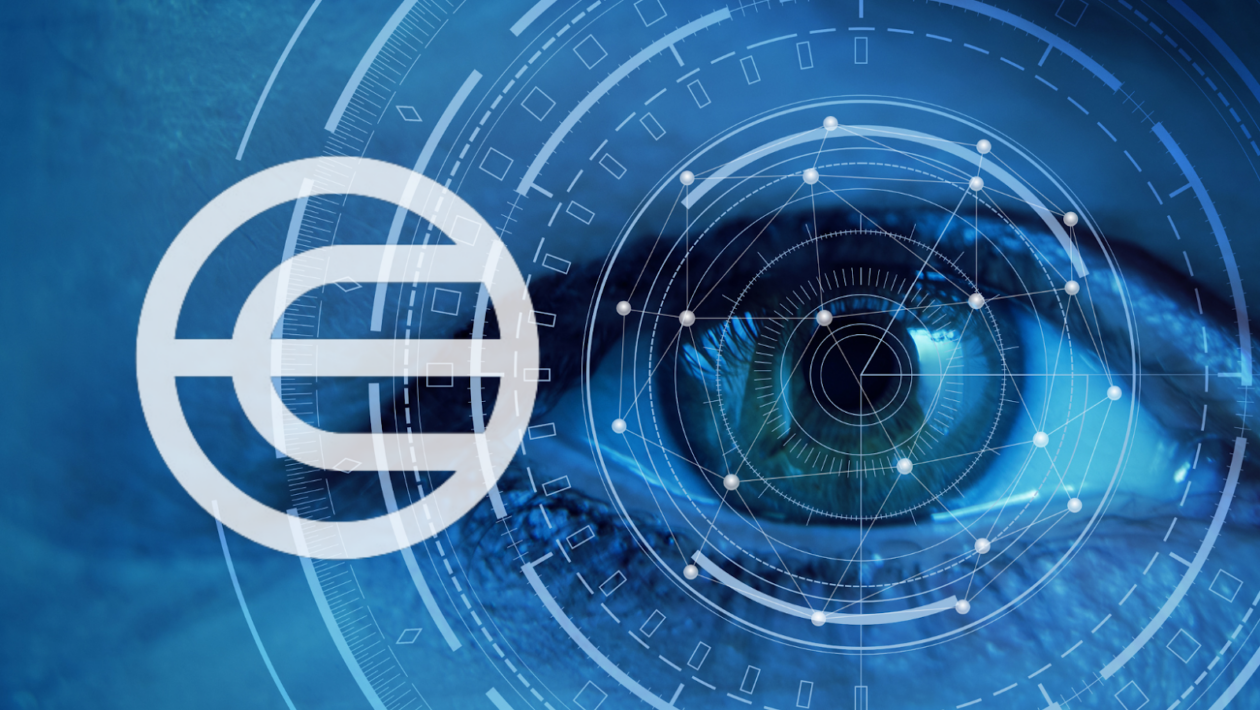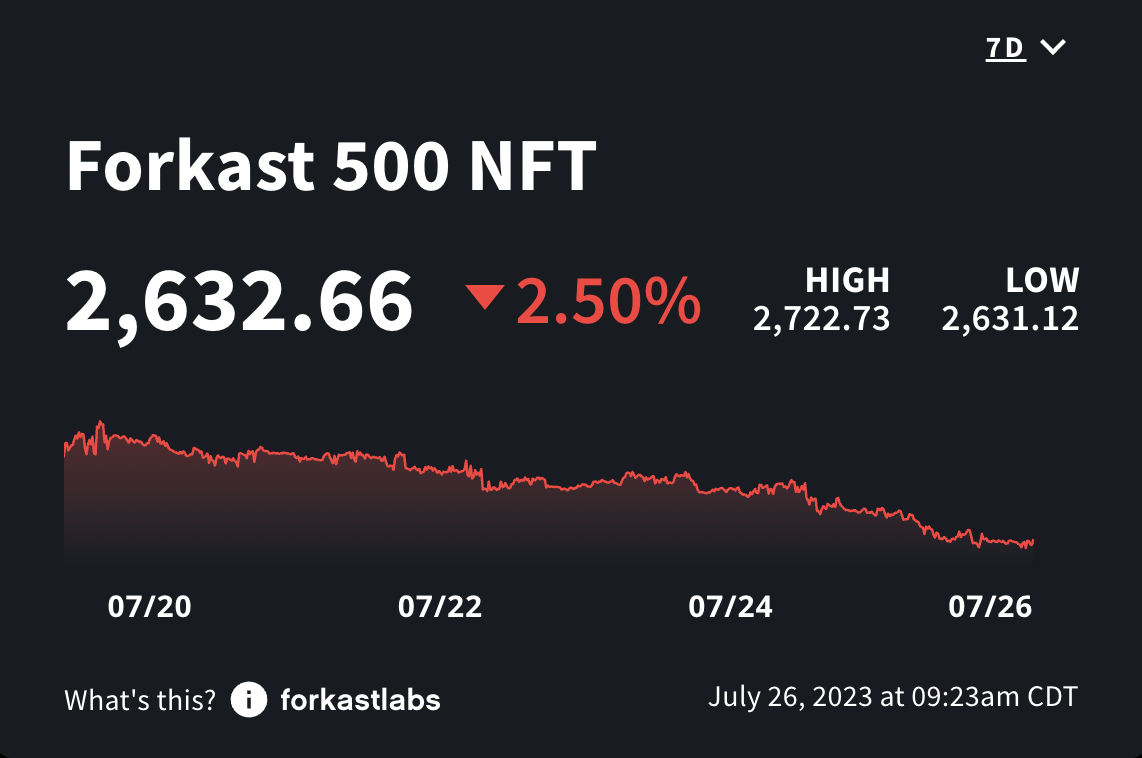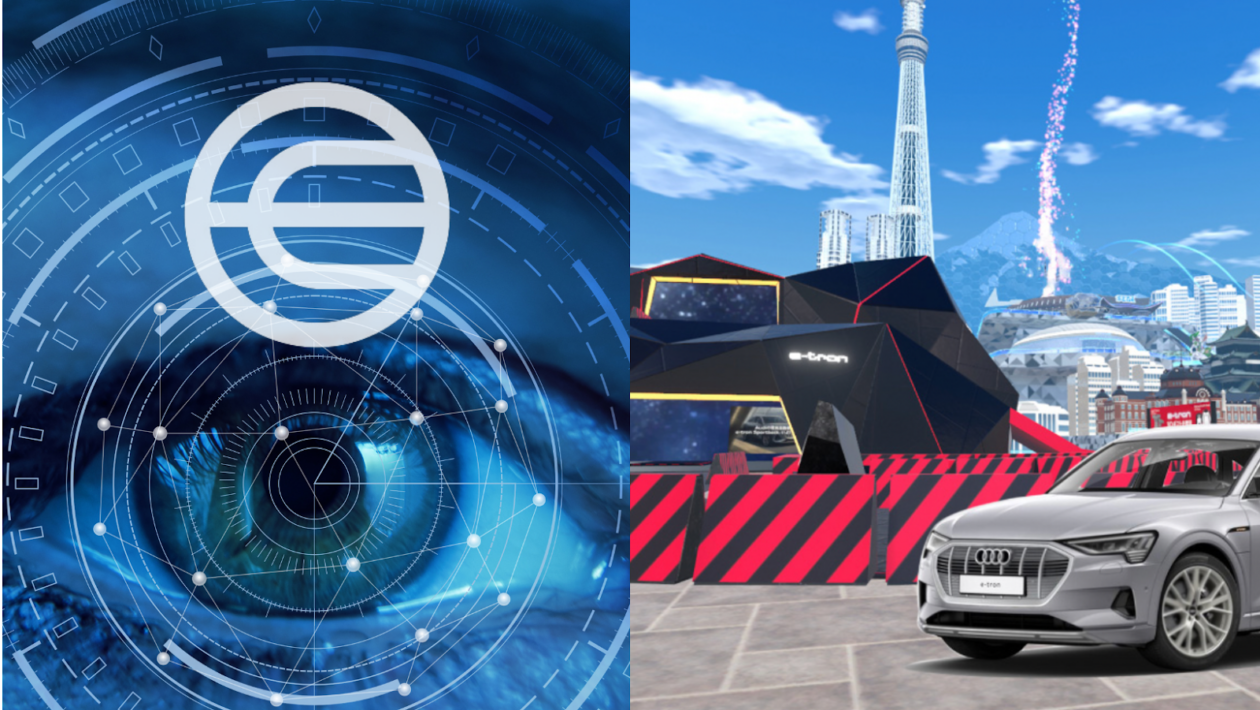In this issue
- Worldcoin’s free crypto: More than just a freebie?
- Forkast 500 NFT Index: NFTs find ways to grow
- Japan’s metaverse ambitions: More support ahead for Web3
From the Editor’s Desk
Dear Reader,
We’re accustomed to references to digital assets as “the future of finance.” And, since those references just happen to ring true, we rather like them, actually.
We’re less used to characterizations of cryptocurrencies, specifically, as gateway enablers of a dystopian future. If anything, the crypto phenomenon has a streak of the opposite — utopianism — deep in its intellectual DNA.
The mainnet launch of Worldcoin this week may have changed that somewhat. The first reaction of most people to schemes that scoop up their most intimate personal information — in Worldcoin’s case, through iris scans – is that it’s none of Big Brother’s damned business.
Worldcoin’s professed aim of ushering in a guaranteed basic income for everyone on the planet may be laudable, but it certainly doesn’t take much imagination to see the dystopian potential of its apparently utopian mission.
Whether it’s a trailblazing triumph, a Musk-era-Twitter-style flop, or an open door to an Orwellian future, there’s no doubt that its towering ambition involves nothing less than an attempt to reshape the world.
And reshaping the world seems to be in vogue these days, as the resources being thrown at metaverse development suggest. These efforts may harness the utility-rich potential of metaverse technology to change the world in a million smaller ways that collectively promise much more sweeping changes to the place we all inhabit.
However specific and currently small-scale, they all involve aiming big. Indeed, aiming big won us many of the best examples of innovation we enjoy today – not least digital assets. Imagine if Satoshi had said Bitcoin was just too hard.
Yet sometimes, it is good to remember that aiming big has produced not only some of humanity’s finest achievements, but also its most shameful tragedies. With this in mind, Worldcoin co-founder Sam Altman, for one, might want to ponder the fact that one person’s utopia is usually someone else’s dystopia.
Until the next time,
Angie Lau,
Founder and Editor-in-Chief
Forkast.News
1. No free lunch

Worldcoin, a cryptocurrency project co-founded in 2019 by OpenAI chief Sam Altman, launched its mainnet and WLD token on Monday, offering free crypto to eligible users for “simply for being human” in a move that is raising industry concerns over privacy, accessibility and security.
- Regulators are also venturing into the fold, with the U.K.’s Information Commissioner’s Office saying on Tuesday that it will be making enquiries on the Worldcoin project, according to Reuters. The project is also unavailable in the U.S. due to regulatory restrictions.
- Ethereum co-founder Vitalik Buterin expressed his concerns in a Monday blogpost, pointing out potential issues in privacy, accessibility, centralization and security. He added that the decentralized proof-of-personhood solution that Worldcoin works towards is “one of the most valuable gadgets that people in the Ethereum community have been trying to build.”
- On Worldcoin, which aims to build a global identity and financial network, users receive a World ID by scanning their iris through hardware named “Orb” to confirm their identity and receive WLD cryptocurrency as a reward.
- Through this network, Worldcoin aims to build a universal basic income funded by artificial intelligence, which will be equally distributed to its users.
- Upon signing up for a World ID, users in countries that allow the operation of Worldcoin can receive 25 WLD tokens as a “genesis grant.” Each user can then claim a free WLD token each week with no cap on the total number of tokens, according to the Worldcoin website.
- After launching its application in May 2022, Worldcoin reached a milestone of 2 million World ID sign-ups on July 13, 2023, and now aims to increase the number of Orbs to 1,500 this summer and fall across some 35 cities in more than 20 countries.
- The WLD token is listed on some major crypto exchanges, including Binance, Bybit, Huobi and OKX. It peaked at US$3.58 on Monday and is trading at US$2.21, moving down 6.71% in the past 24 hours, according to data from CoinMarketCap.
Forkast.Insights | What does it mean?
Worldcoin, launched on Monday, marks its distinctive presence as a digital identity venture. The modus operandi involves scanning individuals’ eyes using specially designed cameras known as “Orbs” to obtain biometric data. Users that register their data are subject to Worldcoin airdrops to their Ethereum address, the network where the cryptocurrency operates.
The goal of integrating a digital identity and economic layer is to pave the way for implementing universal basic income — a concept that Worldcoin co-founder Sam Altman firmly believes will become a necessity in light of the explosive growth of artificial intelligence.
Worldcoin’s Orbs have scanned over 2 million individuals worldwide, setting an ambitious target of reaching nearly a quarter of the global population — approximately 2 billion people. This initiative raises significant privacy concerns that Worldcoin aims to assuage with financial incentives.
The idea of “free money” may be appealing, but skeptics argue that it may not be a sufficient driver to enroll 2 billion people into the system. As per a report by the MIT Technology Review, Worldcoin’s initial batch of half a million people largely comprised the underprivileged, predominantly from developing nations.
With Orb verifications conducted in 34 countries, Worldcoin recently announced plans to expedite the distribution of Orbs in the coming months. The company plans to deploy an additional 1,500 Orbs across 35 more cities during the summer and fall.
Notably, as it stands, Worldcoin’s reach will not extend to the world’s two largest economies, the U.S. and China. While U.S. metropolises like New York and Los Angeles are on Worldcoin’s Orb tour, the firm’s terms and conditions have ruled out the availability of WLD tokens to U.S. individuals or entities.
From a market performance perspective, Worldcoin presents an interesting case. On the one hand, it’s attempting to capitalize on the growing interest in digital currencies while addressing the possible need for universal basic income. On the other hand, privacy concerns and limitations on the availability of tokens might constrain its potential. The project’s success will depend largely on how it navigates these challenges and evolves in response to market dynamics and regulatory environments.
2. Growth, but sideways

The summer slump continues in NFTs, with the Forkast 500 NFT Index reflecting an NFT market with weaker volumes and sales. This week, the index declined 2.5% to another new all-time low at 2,632.66.
- Among blockchains tracked by Forkast Labs indexes, the Cardano NFT ecosystem was the sole chain to gain this week, with the CAR NFT Composite up 1.19%. The Ethereum, Solana and Polygon NFT Composites all declined.
- Blockchain sales volume mostly decreased from last week, with Ethereum, Polygon and ImmutableX all falling under 10%, as Bitcoin declined 67% and Solana lost 23.4%. BNB was the only top five blockchain with higher sales volumes this week, rising 8.48%
- Ethereum’s US$4.1 million in sales on July 21 stood at a daily low since June 10, 2021, when sales stood at US$3.3 million in sales.
- Global sales volume shrank 40.33% this week with US$74.7 million in sales, down from US$112.4 million last week.
- Average global sales prices declined 40.14% to US$43.17 from US$64.85 last week.
- Sellers were on the losing end of trades this week, losing US$8.1 million across blockchains.
Forkast.Insights | What does it mean?
Growth isn’t always vertical, with up or down movement on a chart. While the indexes again reflect significant loss of value this week, some NFT collections found other ways to grow in a still young NFT asset class.
The CyberKongz announced its move to one of Ethereum’s earliest side-chains, taking part of their new NFT collection, Genkai, to the Ronin blockchain. Ronin is home to the world’s top-ranked NFT collection Axie Infinity, which has traded over US$4.2 billion on secondary markets. It’s not often that you’ll find a project of CyberKongz’s size, one that has seen over US$300 billion of action on secondary sales, move homes. You will have to look back to Gods Unchained, which moved from Ethereum to Immutable X, Axie Infinity, which moved from Ethereum to Ronin, and DeGods, which moved from Solana to Ethereum, to find moves of similar magnitude.
This is the beginning of an acceleration towards deeper collaboration between projects, many of which may lack funds and direction. It shouldn’t be assumed that NFT builders have the experience to navigate a market that offers little profit and no margin for errors. Some even had no expectation of the success they found, but they now have the burden of collectors who demand results. Working together offers more chances for success though it may be necessary for survival for some.
Yuga Labs didn’t just show that they were ahead of the curve last year with its purchase of the CryptoPunks. They’re doing it again with the launch of a new IP licensing platform for Bored Ape holders. In another demonstration of growth this week, Yuga Labs’ new Made By Apes platform will allow businesses to lease BAYC holders’ NFT images through an on-chain license agreement. The on-chain, no-middleman-needed platform pushes a prime use case of NFTs to the forefront, and the networking that will be possible through Bored Ape branded products is a bigger deal than most that are currently appreciating. Yuga Labs deserves accolades for pushing the NFT space forward beyond what most currently give them credit for.
The Pudgy Penguins will also release a new IP licensing platform as soon as this month. This follows a successful San Diego Comic-Con that sold thousands of physical Pudgy Penguin toys to a non-NFT audience.
OpenSea took large steps forward with the release of an NFT trading utility on its website. Traders can now offer combinations of NFTs and WETH with other NFT holders with no fees or royalties involved. From a security standpoint, after years of fake trading platforms have led to millions of dollars worth of NFTs being stolen, OpenSea’s new product is a giant value-add to the NFT space.
This week’s moves add tremendous value to NFTs, and while it’s hard to tell if the inflated market had such innovations priced in too early by speculators, there is no doubt that they add significant value to the ecosystem as a whole. It’s exciting to see building taking place in an otherwise pretty depressing market.
3. Japan’s next big thing?

A major Japanese firm might be on the cusp of unveiling the nation’s next big metaverse project at the WebX conference in Tokyo, said Prime Minister Fumio Kishida as he pledged stronger policy support for the Web3 industry.
- “I have heard that a large Japanese company will take this opportunity to announce to the world a big, ambitious project that aims to create a valuable economic system in the metaverse,” said Kishida in a recorded video at the conference.
- Japan, an early believer in blockchain and cryptocurrencies, has become increasingly supportive of emerging metaverse technology as a pillar of the country’s economic future.
- Kishida also said that Web3 is part of “the New Form of Capitalism,” an economic strategy that he first revealed in June to boost government investment in areas including digital transformation, start-ups and technology.
- “The administration is proactively supporting domestic startups including the Web3 industry,” Koichi Hagiuda, chairman of the Policy Research Council of the Liberal Democratic Party, said in his opening remarks at the conference.
- The conference is part of Japan’s efforts to become a global Web3 hub as it faces similar competition from regional economies such as Hong Kong, South Korea and Singapore.
- Managed by Japanese Web3 media firm CoinPost, WebX is a global Web3 conference that aims to position Japan as “the Web3 center of Asia” and accelerate the mass adoption of Web3 technologies.
- In April, a government-affiliated white paper discussed Japan’s path to widespread adoption of Web3 technology, including crypto. The East Asian nation also raised entry barriers to the crypto industry by introducing tougher anti-money laundering rules in June.
Forkast.Insights | What does it mean?
Utter the word “Metaverse” and watch people cringe. The project that Meta founder and chief executive Mark Zuckerberg promised would be the next iteration of the internet, changing the way the world worked, turned out to be nothing but an unpeopled, barren money pit.
Small-M metaverses have also underwhelmed, even if they have not (yet, at least) joined Zuck’s failed big-M virtual world on the scrapheap of bad tech ideas.
The Sandbox, launched with an immodest dose of hype in late 2021, attracted around 1,760 active users in the seven days before this edition of The Current Forkast was published, according to Web3 dApp data platform DappRadar.
Decentraland, The Sandbox’s main rival, had about 1,000 — users in both cases defined as unique active wallets transacting with the metaverses’ smart contracts — but numbers like these are hardly evidence that we’ve all quit reality for virtuality.
In this light, news that a Japanese corporate heavyweight may take the covers off a big local metaverse project might be a little difficult to get excited about.
Yet Northeast Asian countries are racing to build metaverse projects. Five months ago in Japan, a group of 10 manufacturers announced an agreement to develop a project called Ryugukoku, which will form part of a planned Japanese Metaverse Economic Zone to compete with similar projects in South Korea and China.
A number of proposals to promote and regulate the metaverse industry are awaiting decisions from South Korea’s legislature, although no proposed bills have made it to the discussion stage during plenary sessions.
China’s plan to become a leading force in metaverse technology might conjure a vision of a Communist Party-controlled virtual world even more dystopian than what the party has created in the world’s second-biggest economy and formerly free Hong Kong. But who would want to inhabit a metaverse run on “Xi Jinping thought” algos? Mercifully, it’s industry that’s the target of China’s metaverse efforts.
It’s in uses such as industry that metaverse technology might finally hit its stride. As such, although the investment and effort going into metaverse projects in Northeast Asia has an inevitable whiff of “a solution looking for a problem” about it, there’s an unmistakable glimmer of promise in the numerous applications that the technology has beyond the big, bland, empty landscape of a California tech billionaire’s childlike imaginings.




